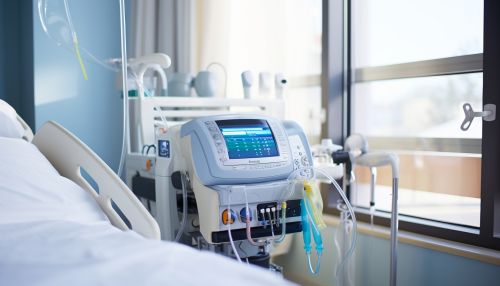Ventilator
Introduction
A Ventilator is a machine designed to provide mechanical ventilation by moving breathable air into and out of the lungs, to deliver breaths to a patient who is physically unable to breathe, or breathing insufficiently. While modern ventilators are computerized machines, patients can be ventilated with a bag valve mask, a simple hand-operated bag-valve mask.
History
The history of the ventilator can be traced back to the earliest days of medicine, when physicians would manually ventilate patients using a bellows. The first positive-pressure ventilators were developed in the early 20th century and were used to treat patients with polio, a disease that often resulted in respiratory failure. The iron lung, a negative pressure ventilator, was used extensively during the polio epidemics of the 1950s.


Types of Ventilators
There are two main types of ventilators: invasive and non-invasive. Invasive ventilation involves the use of a tube inserted into the trachea, while non-invasive ventilation uses a mask or similar device to deliver air to the lungs.
Invasive Ventilation
Invasive ventilation is typically used in critical care settings, such as intensive care units (ICUs), and during anesthesia. The patient is usually sedated or anesthetized, and a tube is inserted into the trachea to deliver air directly to the lungs.
Non-Invasive Ventilation
Non-invasive ventilation is used in less critical situations, such as in the treatment of sleep apnea, and does not require sedation or anesthesia. The patient breathes through a mask that is connected to the ventilator.
How Ventilators Work
Ventilators work by delivering air to the lungs at a pressure that causes the lungs to expand. This pressure is known as positive pressure. When the lungs expand, they draw in fresh air, which is then exhaled naturally by the body. The ventilator adjusts the pressure and volume of air delivered to the patient based on their specific needs.
Clinical Applications
Ventilators are used in a variety of clinical settings, including intensive care units, emergency departments, and operating rooms. They are also used in the treatment of chronic respiratory diseases, such as chronic obstructive pulmonary disease (COPD) and asthma. In addition, ventilators are used during surgical procedures that require general anesthesia, as these procedures often impair the patient's ability to breathe on their own.
Risks and Complications
While ventilators are life-saving devices, they are not without risks. Complications can arise from the use of ventilators, including lung damage, infections, and barotrauma. It is crucial that healthcare providers monitor patients closely while they are on a ventilator to minimize these risks.
Future Developments
The field of mechanical ventilation continues to evolve, with ongoing research aimed at improving patient outcomes and minimizing complications. Future developments may include more sophisticated ventilators that can better mimic natural breathing patterns, as well as advancements in non-invasive ventilation techniques.
